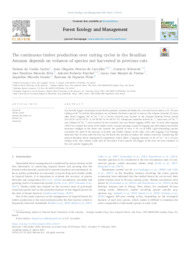The continuous timber production over cutting cycles in the Brazilian Amazon depends on volumes of species not harvested in previous cuts.
The continuous timber production over cutting cycles in the Brazilian Amazon depends on volumes of species not harvested in previous cuts.
Autoria: CASTRO, T. da C.; CARVALHO, J. O. P. de; SCHWARTZ, G.; SILVA, J. N. M.; RUSCHEL, A. R.; FREITAS, L. J. M. de; GOMES, J. M.; PINTO, R. de S.
Resumo: Can heavily logged Amazonian dense forests produce commercial timber for a second harvest under a 25?35-year cutting cycle? To address this question, we evaluated the forest capacity to recover the volume extracted 32 years after heavy logging (90 m3 ha?1) in a 144-ha research area located in the Tapajós National Forest, Brazil (03°18?31? to 03°19?21? S; 54°56?28? to 54°56?15? W). Abundance (number of trees ha?1), basal area (m2 ha?1) and volume (m3 ha?1) were assessed in two censuses, one year before logging (1981) and 32 years after logging (2014) to evaluate the status of the timber stock. Canopy openings caused by logging and silvicultural treatments increased sunlight in the forest and boosted the growth of trees 5?45 cm in DBH. Light-demanding species accounted for most of the increase in density and timber volume in the study area after logging. Our findings indicated that 32 years after the first cut, the forest was not able to replace the volume extracted. Considering the present Brazilian forest management regulations, which allow a logging intensity of 30 m3 ha?1 in a 35-year cutting cycle, this volume could only be harvested if new species not logged in the first cut were included in the new species logging list.
Ano de publicação: 2021
Tipo de publicação: Artigo de periódico
Unidade: Embrapa Amazônia Oriental
Palavras-chave: Amazonia, Annual allowable cut, Madeira, Second cut, Timber yields
Observações
1 - Por padrão são exibidas publicações dos últimos 20 anos. Para encontrar publicações mais antigas, configure o filtro ano de publicação, colocando o ano a partir do qual você deseja encontrar publicações. O filtro está na coluna da esquerda na busca acima.
2 - Para ler algumas publicações da Embrapa (apenas as que estão em formato ePub), é necessário ter, no celular ou computador, um desses softwares gratuitos. Sistemas Android: Google Play Livros; IOS: iBooks; Windows e Linux: software Calibre.
Acesse outras publicações
Acesse a Base de Dados da Pesquisa Agropecuária (BDPA) para consultar o acervo completo das bibliotecas da Embrapa.

